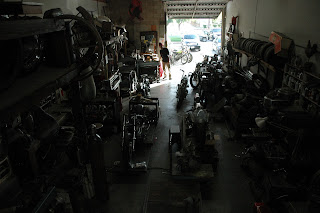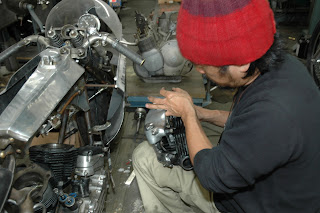I flew into L.A. on a Saturday. I called the shop to see if Shinya would be there. His wife, who speaks better English and handles all the phone calls, assured me was working, in a tone of voice that suggested it was a stupid question; he was in the shop all day, every day.
Azusa is a bland, industrialized suburb up on the north side of L.A. where miles of urban sprawl run into the Santa Monica mountains. Even though I had the address of Chabbott Engineering (Chabott means 'fighting rooster' in Japanese) I drove right past it a couple of times before spotting an open garage door with four or five trashed '70s bikes basking in the sun.When I finally realized that hole-in-the-wall was the place I was looking for, I had one of the most satisfying afternoons I've ever had as a writer. To spend a virtual hour cooped up with Shinya Kimura, click that tantalizing 'Read more' link and, well, read more...
Shinya emerged, squinting. “Sorry my bad English,” he said. Then he explained the basket cases. “These junk are all mine. I have a plan for every one, but I have no time.” Inside, it took a moment for my eyes to adjust. Chabbott occupies a single bay, maybe 20 feet wide and sixty feet deep, with a double-height ceiling. Heavy steel shelving units piled with old frames and wheels, tires and motors make it seem narrower.
In Zen and the Art of Motorcycle Maintenance, Pirsig describes two types of mechanics: the orderly ones with clean, bright shops and another kind who can scan a jumble of parts and tools, and put their hand on just the thing they need. Shinya's definitely the latter type. There's no CNC machinery to be seen; his Bridgeport lathe and mill were all bought (very) used.
Mixed in with the junk and personal projects, a '47 Knucklehead chopper, built for a customer, has an art deco vibe. The carb has an elaborate brass cover, part of a 1930's plumbing fixture that Shinya found in a junk store. The craftsmanship and metalwork is fascinating, but it's not to my taste. Another customer's cafe-racer – a bike he built around a '67 Bonneville motor in a Trackmaster frame – is cleaner with a stark steam-punk vibe.
Right now, a customer's '74 MV Agusta America project is paying the bills. Shinya does motors, chassis and bodywork himself – everything except powder-coating and leatherwork; a friend does his saddles. It took him six weeks of hammering, welding, grinding and polishing to turn about 30 pieces of alloy the MV's fuel tank. At that rate, he releases a couple of bikes a year.
There a little loft up above the back of the shop, and three of his own bikes are parked up there. The smallest is a bobber built around a '62 Honda C100 50cc motor. You could hang it on the wall, but it was road legal and registered in Japan; he rode it on the street in Tokyo for several years. There's a gorgeous single-carb Triumph 650 motor in a frame he built himself, and '14 Excelsior 'big twin' – another salt flat project.
He grew up in the Aichi prefecture, in the countryside south of Tokyo. He studied entomology at university. That might account for his aesthetic; the organic shape of the gas tank he made for that MV evoked the shape of a beetle, and his Excelsior's fuel tank has a vaguely insect-like exoskeleton.
He started working on bikes full time straight out of university, and raced vintage Harleys in a Japanese class called AVCC, which stands for American Vintage Classic Competition. He owned a custom shop called Zero Engineering in Tokyo, where he supervised a staff of six guys. “I'm real tired to manage other people,” he told me.
He moved to the 'States partly because he was running from something and partly because he'd grown up fascinated by American hot-rods. As he got into his forties, he found it harder and harder to relate to the Japanese custom culture, which was all kids. “Here, 70 year olds are still racing,” he said of the U.S. scene. “There, older people play with their grandchildren.”
He opened up a Zero Engineering shop in Las Vegas, and appeared in 'Biker Build-Off'. That part of the story's pure Hollywood, and from here you'd expect this story to follow a predictable script, where his customers are movie stars and posers, he becomes a reality-star 'brand' himself, gets divorced, and along the way the bikes turn to shit but the T-shirts sales are great, and his logo appears stuck in the back of pickup truck windows. There's even a successful spin-off show devoted to his tattoo artist. Except that somehow, that didn't happen.
Having lived in Southern California for the better part of a decade, during which time I myself was one of those pathetic characters carrying schlepping a screenplay with me at all times, I can attest to just how seductive it is, when you're close to that star-machine. Shinya was nearly there; so close he could taste it, but what's been so sweet for cats like Jesse James and the Teutels was bitter to him. When my friend Mike Lichter took a group photo of all the Biker Build-Off contestants in 2005, Shinya wasn't really in the group, he stood on the very edge of it.
 |
| While this bike, built for a customer, bugs me in some ways, it betrays Shinya's roots as an entomologist. |
Now, except for his wife in the front office, he works completely alone. This isn't just a rejection of the Hollywood star-making machine, it's also a rejection the whole idea of money as a measure of success. Instead of becoming a brand, he's producing a few bikes a year. Even though they don't come cheap, by any means (he mentioned $60,000 as a starting point) that rusty van is not a style statement; it's what he can afford.
Azusa is about as far from L.A.'s glamour as it gets. His shop's there because there are great canyon roads five minutes away. When he finishes a customer's bike he keeps it a couple of months and rides it on those roads every day, fine tuning it. “Motorcycle must be functional for me, to ride and be enjoying,” he said. “This is mechanic pride.” It's also only an hour from El Mirage Dry Lake, which is basically one of the Stations of the Cross, if you grew up idolizing the American hot rod and drag race scene.
Between the time I visited him in his shop, and the time I wrote up this story, I played back a voice recorder that I used to interview him. He's a man of relatively few (English) words, but even at that I was struck when I listened back over the recording. Almost all the talking is me muttering to myself; the bikes he makes are that beautiful in the metal; even good photos don't really do them justice. He clearly has a 'style,' but every high-end custom builder can lay claim to a style. But it's not something that's put on; there's no sense at all that he's ever asked himself, 'What will sell?'
Shinya's aesthetic has permeated every aspect of his life, and it is expressed in metal when he works on bikes – not because that's what he consciously sets out to do but because it simply happens. When I asked him if, before setting out on a new build project, he made sketches or devised a plan of attack he told me that he didn't, then he mimed the act of picking up a hammer and shaping a piece of metal, saying “I just start.”
Walking down the rickety stairs from the loft area above his shop, I felt the way an arts journalist might have felt after visiting Picasso's studio. Shinya doesn't mind other people talking about him as an artist, but I almost had to badger him into giving me his own opinion. “I have two face – sculptor and mechanic. But mechanic number one," he finally admitted.
 |
| "I don't want to be bigger, famous rock star,” Shinya told me at the end of my visit. Then he looked around his shop and added, “This is my goodness.” |






No comments:
Post a Comment